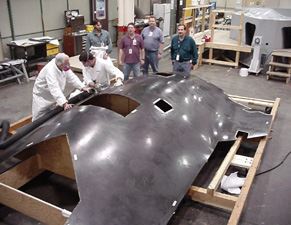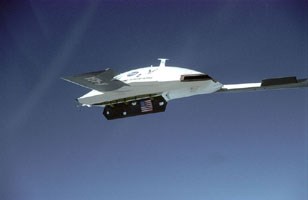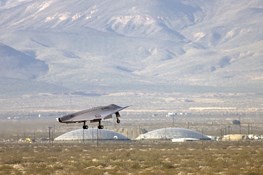Composites combat ready in UCAVs
As unmanned aircraft are designed from inception for combat duty, composites will carry the payloads in structural components.
Among 49 goals outlined for the U.S. military's next quarter-century of development, the Unmanned Aerial Vehicles Roadmap (Office of the Secretary of Defense, December 2002) lists as its first priority to "develop and operationally assess for potential fielding" an unmanned combat air vehicle (UCAV). While unmanned aerial vehicles (UAVs) designed primarily for reconnaissance missions were retrofitted with lightweight weapons and deployed during the recent conflicts in Afghanistan and Iraq, the Roadmap calls for an unmanned strike vehicle specifically intended to conduct penetrating weaponized missions, including Suppression of Enemy Air Defense (SEAD), armed surveillance/reconnaissance, Electronic Attack (EA), and deep-strike interdiction.
In October 2003 the U. S. Department of Defense (DoD) responded to this directive by launching a joint program of the Air Force, Navy and Defense Advanced Research Projects Agency (DARPA, Arlington, Va., U.S.A.) to oversee UCAV development. Dubbed the Joint Unmanned Combat Air Systems (J-UCAS) program, it now administers ongoing work on two UCAVs: the X-45, under development by Boeing Integrated Defense Systems (St. Louis, Mo., U.S.A.); and the X-47, under development by Northrop Grumman Integrated Systems' Air Combat Systems business unit (San Diego, Calif., U.S.A.). The X-46, a Navy version of the X-45, was folded into the X-45 program, based on the DoD's ongoing interest in fielding interoperable systems among military branches. With rising concerns about access to distant landlocked theaters, J-UCAS increased the previous UCAV program objectives to now include a combat radius of 1,300 nautical miles with a 4,500 lb payload and the ability to loiter for two hours over a target 1,000 nautical miles from base. This will enable the vehicles to carry, for example, two 2,000-lb Joint Direct Attack Munitions (JDAMs).
The U.S. Air Force wants UCAVs to serve as "first day of the war" force enablers, performing SEAD missions, preemptively destroying or electronically suppressing enemy air defense systems in support of manned strike missions. SEAD is considered one of the most dangerous missions for piloted aircraft. The Air Force also highly values the "persistence" that these new weapon systems bring to the Battle Commander. They can stay on station a long time (no pilots to get tired) and continue to collect and pass critical sensor information as it becomes available - all because they are there. The Navy's UCAV will be carrier-based and, for the first time, will provide the Navy with a penetrating intelligence, surveillance and reconnaissance (ISR) weapon system that will enable prosecution of an Anti-Access War (in which naval forces encounter mines, quiet submarines or swarming small boats) with the same persistence and SEAD/strike capabilities as the Air Force model.
First flight of an Air Force UCAV is planned for 2006 while the Navy version should take flight in 2007. Current procurement plans include delivery of UCAVs by FY 2008 for operational assessment by the user-war fighters. While Boeing and Northrop Grumman completed separate Phase I programs for the Air Force and Navy respectively, the J-UCAS office describes the current scenario as "developing acquisition strategy options." Naturally, each company hopes to provide all the UCAVs for both services, but each also could envision fieldable squadrons of both X-45 and the X-47 serving different mission objectives.
Composites spiral in
Of interest to the composites industry is the military's new approach to procurement. In conventional development schedules, enabling technologies are rigidly determined in an early design phase. By contrast, J-UCAS is conducting multiple, overlapping "spirals" of development, which allow technological advances and changes of concept to be incorporated during each phase as customer's needs evolve. "There are milestones and periods where we can insert new materials and processes," says Steve Schwedt, Boeing airframe team leader for the X-45 program. "The challenge to the industry is to have them ready." He suggests that this approach may reward those investing in basic research.
To hasten UCAV deployment, development "spirals" will produce demonstrator vehicles that can be fielded in combat. Unlike conventional demonstrators, which often incorporated only some of the technologies needed for field service, the new UCAVs will be battle ready. As a result, Schwedt points out, the Air Force and Navy versions of X-designated aircraft are different even in this early developmental phase. Furthermore, says William Barksdale, Boeing Air Force Systems communications, "The unmanned industry is moving a lot faster than traditional fighter developmental has. You don't know when the next chapter in the war on terror is coming. We take what the military wants and incorporate it so that it's out in the field in a few years. Combat pushes this urgency even more."
Combat duty also entails new challenges for composites technologies and structures. "Performance of SEAD and strike will demand a more robust capability in terms of weapons load and survivability," the UAV Roadmap reports. "Survivability gives you several derived requirements" that pertain to composites, notes Northrop Grumman's X-47B deputy chief engineer Dan Rihn. For example, he points out that unmanned aircraft with dropped payloads require cutouts in the fuselage that must not produce greater observability. "The alignment of the weapons bay door and the seal of the door has to remain tight and intact - a smoother juncture than in a commercial aircraft." With no openings other than weapons bays, the UCAV's nearly seamless composite skins complement their smaller size - about half that of manned counterparts - for lower observability.
Survivability also necessitates elusion. "Strike aircraft experience higher g-loading to evade surface-to-air missiles," Rihn says. "The structure can't be as light and fragile as a U-2." Although early thinking about unmanned combat vehicles included greater maneuverability than manned aircraft (since g-forces could exceed those that human pilots could tolerate), maneuvering demands in UCAVs actually will be equivalent to manned fighters, Rihn observes. "Over the years, we haven't found application for high-g maneuvering. And, you'd need a tremendous thrust-to-weight ratio to be able to maintain a high level of energy. You'd have a very highly powered vehicle that's not very fuel efficient or economical." Demand for long ranges and loitering capabilities trump such maneuverability.
In fact, from the 1990s UAV objectives of running "dull, dirty and dangerous" missions, the "dull" - missions of long duration - have emerged as the most valuable. Long ISR missions certainly benefit from unmanned vehicles, but the case is even stronger for combat missions. Physical and mental demands on pilots peak when they must travel to distant theaters, loiter for the opportune timing, carry out combat operations in highly stressed environments, and then fly home. Replacing piloted aircraft in such missions, UCAVs are therefore being designed with "a premium on fuel fraction," Rihn reports. "If I can take a pound of weight out of the structure, I can carry a pound more fuel." Composites technologies that reduce weight are, of course, of prime interest.
Integrating lightweight ballistic protection into composite skins, a patent-pending ballistic-resistance technology from V System Composites (VSC, a division of DR Technologies Inc., Anaheim, Calif., U.S.A.) could aid unmanned vehicles in both range and survivability. VSC developed this technology under internal R&D and an SBIR grant for a missile application, and the company expects to apply it to an undisclosed UAV program on which it is working. The technology is a lightweight composite solution exhibiting an areal density of only 7.4 kg/m² (1.5 lb/ft²) while providing NIJ-III-A protection (the equivalent of a 9-mm full-metal jacket round, the same requirement that commercial aircraft cockpit doors are meeting). The technology also prevents backside spalling, keeping structural integrity intact around the bullet.
If combat readiness raises the bar for composite structures, naval operations raise it yet again. The tight spaces and increased handling on carrier decks warrant tougher design goals for durability and impact resistance in composite components, Rihn notes. "If we designed just for flight loads, the deck crew couldn't push" the aircraft around the deck as they need to. The effect on composites of ocean salt spray must be considered as well. Carrier demands also illustrate where metals are still likely to be specified. Schwedt explains that with tailhook landings, "where there are very high complex loads both in- and out-of-plane, the use of the planar-efficient composites may not be the best application." Even a quasi-isotropic laminate design for a composite structure is not as effectual in such cases as fully isotropic metals.
X-45
Prior to the launch of J-UCAS, Boeing Phantom Works (Seattle, Wash., U.S.A.) designed and built two UCAV X-45A demonstrators for DARPA and the Air Force under a $256 million contract, with a successful first flight in May 2002. Test flights later this year will demonstrate how the two vehicles can fly together in coordinated operations. A manned X-45 surrogate aircraft, the T-33, assists in risk reduction. It mimics the X-45A in flying autonomously, but the pilot can take control if needed.
The X-45A features a wingspan of 10.3m/33.8 ft, length of 8m/26.3 ft, and an empty weight of 3,640 kg/8,000 lb. A payload capacity of 680 kg/1,500 lb includes one working weapons bay (an avionics pallet occupies the other bay). The aircraft's low profile in flight (only 1.1m/44 inches tall) aids low observability. Composite features of the X-45A include wings built at Foam Matrix (Inglewood, Calif., U.S.A.) using the company's patented Foam Matrix Core (FMC) process (see "Unmanned Composite Aircraft Patrol the Skies," HPC May 2002, p. 18).
The X-45A fuselage consists of composite skins with high-speed machined aluminum keels, spars and bulkheads. Advanced Composites Group's (Tulsa, Okla., U.S.A.) LTM45EL extended-life woven carbon/epoxy, a low-temperature-cure prepreg, was layed up for skins, inlet ducts and doors on tooling supplied by Janicki Industries (Sedro Woolley, Wash., U.S.A.). The low-temperature-cure prepreg "allowed us to use Janicki's boat-type tooling, with a really quick turnaround on two large tools," Schwedt reports. The upper skin, about 9m by 3.7m (30 ft by 12 ft), was layed up in one piece while the lower skin was produced in two 4.5m by 3.7m (15 ft by 12 ft) sections. Over and under the exhaust nozzle, separate skins were made from BMI-5250-4 carbon/bismaleimide prepreg from Cytec Engineered Materials (Tempe, Ariz., U.S.A.). This product cures at 177°C to 204°C (350°F to 400°F) and provides a service temperature range of -59°C to 204°C (-75°F to 400°F).
Under its $540 million (USD) contract, Boeing received permission to scrap the X-45B moniker to incorporate the new J-UCAS payload, range and persistence objectives in the X-45C vehicle it is currently developing. Boeing will build three aircraft equipped with two full weapons bays and more low-observable technologies. With a length of 11m/36 ft and wingspan of 14.6m/49 ft, the X-45C will have a flying weight of 15,900 kg/35,000 lb.
The X-45C retains some of its predecessor's features, while other features have been modified in a revised planform that provides for greater fuel-carrying capacity and better aerodynamic performance than previous designs. The removable wings of the X-45A, which required laminate build-up to transfer strains through the attachment lugs, will be replaced with folding wings on the Navy X-45CN. "[The removable wings were] inefficient as far as the skin goes because of the consolidated loads across the lugs," Schwedt notes. "The folded wings have similar advantages, but the joint will be out further on the wing," allowing more efficient skin design at the joint.
Boeing plans to outsource the majority of composites fabrication on the X-45C vehicles. So far, it has tapped AAR (Clearwater, Fla., U.S.A.), EDO Fiber Sciences (Salt Lake City, Utah, U.S.A.) and Northwest Composites (Marysville, Wash., U.S.A.) for various fabrication projects on this program. "Each is looking at some new technologies for fabrication," Schwedt says. "We do a trade study in each case to assess cost, weight and technical maturity."
X-47
In its first flight, in February 2003, Northrop Grumman's X-47A Pegasus simulated a tailhook landing, establishing the design's suitability for carrier-based missions. This flight culminated a company-funded effort to confirm the low-speed handling qualities of a tailless, kite-shaped vehicle for carrier operation, and to demonstrate low-cost, rapid prototyping for a robust unmanned vehicle.
The X-47A Pegasus has a wingspan of 8.5m/27.8 ft and length of 8.5m/27.9 ft, and the aircraft's empty weight is 1,743 kg/3,835 lb. As an aerodynamic demonstrator, the Pegasus does not have an operable weapons bay. Composed largely of composites, the Pegasus was built at Scaled Composites (Mojave, Calif., U.S.A.). Composites played a critical role in rapid prototyping, as Scaled used Advanced Composites Group's LTM45 room-temperature-cure carbon/epoxy exclusively throughout the vehicle's structure. "We didn't autoclave anything," recalls Rihn. "We designed around room-temperature-cure strength capability for fast manufacture." As a result, concept development to first flight took only 12 months. To speed production and enhance low observability, the upper and lower skins of the Pegasus each were made in two halves. Scaled's expertise in one-off fabrication enabled the team to machine the large molds for the skin halves very quickly.
Under the current contract, Northrop Grumman will develop at least two full-scale demonstration vehicles. The company has tapped Lockheed Martin to join its efforts in this phase. The two companies previously worked together on the F-35 Joint Strike Fighter program.
Like the X-45C, the X-47B will use more low-observable technologies and offer two operable weapons bays. The "kite" aerodynamic shape of the X-47A Pegasus, which enables efficient integration of propulsion and weapons, will be combined with a "flying wing" shape for greater aerodynamic efficiency in the new demonstrator. Rihn anticipates that off-the-shelf materials will comprise the X-47B composite parts, again for the sake of rapid prototyping.
Unmanned rotorcraft complete the scene
With a joint DARPA/Army effort sponsoring development of an unmanned combat armed rotorcraft (UCAR), each branch of the U.S. military now has an active program for unmanned combat vehicles.
In July 2003, DARPA and the U.S. Army awarded two Phase II contracts for the UCAR program: one for $8.7 million (USD) went to Northrop Grumman, Sikorsky (Stratford, Conn., U.S.A.) and Kaman Aerospace Corp. (Bloomfield, Conn.), while the other, at $9.4 million, was awarded to Lockheed Martin Systems Integration (Owego, N.Y., U.S.A.) and partner Bell Helicopter Textron Inc. (Fort Worth, Texas, U.S.A.). Phase II will be completed this fall with preliminary design review of demonstrator systems. DARPA and the Army then expect to downselect one team to build two demonstrator vehicles during Phase III of the program.
Suited for the Army's recently developed Objective Force system-of-systems environment, UCAR vehicles will be designed to identify and prosecute camouflaged or otherwise concealed targets in close combat situations, such as densely foliated, mountainous or urban terrain. Survivability will be a premium characteristic for this rotorcraft. Like the UCAVs, UCAR vehicles will be designed for low cost of ownership and for coordinated missions with other unmanned and manned aircraft. With development still in the early stages, prime contractors have released little public information about the use of composites in their UCAR designs.
Northrop Grumman's Phase II effort will be led by its Advanced Capabilities Development (ACD) organization, an internal "think tank" at the company's Unmanned Systems facility in San Diego. Sikorsky will leverage experience developing the RAH Comanche helicopter while Kaman Aerospace will assist in air vehicle development. Northrop Grumman will make the most of its own unmanned rotorcraft experience in developing and fielding the RQ-8 Fire Scout vertical takeoff and landing tactical unmanned system. The Fire Scout is in low-rate initial production for the Navy and Marine Corps.
For the fuselage design, Lockheed Martin likely will rely heavily on Bell Helicopter Textron. Bell brings extensive experience in both manned and unmanned helicopter design.
Down the road
The U.S. military is devoting significant resources to UAV development. The Roadmap reports that more than $3 billion (USD) was invested in UAVs in the 1990s, with another $1 billion between 2000 and 2002. As existing programs mature, it is likely that an additional $10 billion will be spent by 2010. Yet, despite the significant funding, unmanned aerial vehicles are still received with hesitation in some military quarters. The picture of unpiloted aircraft flying in close proximity to manned aircraft and ground troops raises some eyebrows. "As with any new technology, there is naturally some reluctance to transition to a radically new capability," the UAV Roadmap's Executive Summary states. "The need to fully demonstrate UAVs in combat and realistic training environments is critical to the migration of this technology." Rapid development and prototyping, aided by composites technologies, will help meet this need.
Related Content
Heat mapping simulation to improve AFP parts
An optical model developed for Coriolis Composites’ SimuReal AFP process simulation software enables verification of energy distributions during AFP to better define heating laws.
Read MoreImproving carbon fiber SMC simulation for aerospace parts
Simutence and Engenuity demonstrate a virtual process chain enabling evaluation of process-induced fiber orientations for improved structural simulation and failure load prediction of a composite wing rib.
Read MoreThe basics of composite drawing interpretation
Knowing the fundamentals for reading drawings — including master ply tables, ply definition diagrams and more — lays a foundation for proper composite design evaluation.
Read MoreOptimizing a thermoplastic composite helicopter door hinge
9T Labs used Additive Fusion Technology to iterate CFRTP designs, fully exploit continuous fiber printing and outperform stainless steel and black metal designs in failure load and weight.
Read MoreRead Next
All-recycled, needle-punched nonwoven CFRP slashes carbon footprint of Formula 2 seat
Dallara and Tenowo collaborate to produce a race-ready Formula 2 seat using recycled carbon fiber, reducing CO2 emissions by 97.5% compared to virgin materials.
Read More“Structured air” TPS safeguards composite structures
Powered by an 85% air/15% pure polyimide aerogel, Blueshift’s novel material system protects structures during transient thermal events from -200°C to beyond 2400°C for rockets, battery boxes and more.
Read MoreDeveloping bonded composite repair for ships, offshore units
Bureau Veritas and industry partners issue guidelines and pave the way for certification via StrengthBond Offshore project.
Read More
























